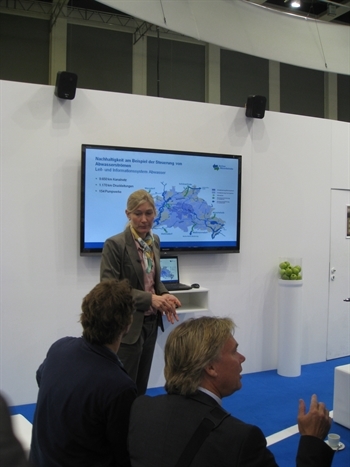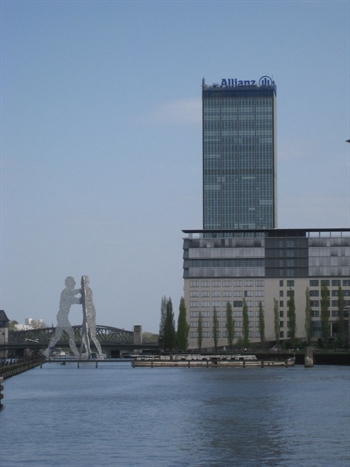
Josh Ellis
Luritec's blend of stormwater management and Placemaking.
For the week of April 22-26, MPC's Josh Ellis was on a tour of water, wastewater, and stormwater industries and utilities with the German American Chamber of Commerce's Midwest office. Stopping in Berlin, Hamburg, and Frankfurt, the group attended trade shows, visited treatment plants, swung by Hamburg City Hall, and more.
Despite the lessons I share below, I have to say that the most amazing thing I learned in Berlin was a few details of history that may or may not have an real bearing on much at all. Berlin's water and wastewater system, as is the case in many old cities, was built a long time ago, certainly well before the city came to be divided jurisdictionally after World War II. What had been one city, one water management entity, one set of pipes effectively became multiple cities, multiple water management entities, but still only one set of pipes. The same pipe network was managed, or at least half-managed, by the East and West, with no official communication back and forth. Whatever water or sewage showed up in the pipes on your side of the border was what you had to deal with, and the same goes for whatever you sent downstream. The only "communication" back and forth was in volumes of water and sewage, and I for one find that pretty remarkable.

Berlinwasser's leadership explains how they design and manage resilient infrastructure.
Josh Ellis
Berlin's water utility today is structured a bit differently than anything we have in northeastern Illinois. It is neither an investor-owned utility nor a municipal department. It is a not-for-profit company owned by the actual municipality of Berlin (which is also a state), but Veolia also has a substantial share in the company, and a seat on the Board of directors. Because it operates as a somewhat separate enterprise, the staff leadership I spoke with believe the long-term management of the utility is less readily affected by short-term changes in elected officials, or the current financial situation of the municipal-state government. This in itself is something worth paying attention to, but not what I'll focus on here.
In other respects, Berlin operates much like a combination of the City of Chicago Dept. of Water Management and the Water Reclamation District of Greater Chicago. 9 water treatment plants (all groundwater), 6 wastewater plants, all serving about 4 million people. Like Chicago/MWRD, there is a combined sewer system for stormwater and wastewater throughout most of the service area, and again like us, that system overflows pretty frequently. How they deal with all that is where we might stand to benefit.
- As is the case in northeastern Illinois, per capita water consumption is dropping in Berlin. Improved plumbing, higher water rates, a general predilection toward conservation, and some shifts in the economy (more services, less heavy industry) all lead to reductions in per capita use, and if that outpaces population or business growth, that can lead to reductions in overall use as well. That's what is happening. But the same number of pipes and pumps are in the ground and need to be maintained, which can be trick with declining revenues. So the water company established a multi-part water rate system that includes a base fixed charge with a variable, consumption-based charge layered over it. The base charge is sufficient to cover fixed capital expenses, debt obligations, and basic overhead. The additional variable charge provides an incentive for efficient use, but also provides additional revenue for future investment. There are examples of rate structures in Illinois - but in my experience it's rare that even a simple complex rate systems gets used by such a large utility.
- At first glance, Berlin's water system (the pipes, not the aquifers, which they claim are abundant and re-charged by ample rainfall) does not appear too resilient. The system is constantly running, pumping groundwater, with absolutely no storage. No water towers, no reservoirs, nothing. All the currently-potable water Berlin has to offer is in a pipe somewhere, and the rest is still in the ground. This is very similar to Chicago itself, which unlike most of the suburbs has no distributed storage in water towers. Chicago's water storage, more or less, is Lake Michigan. If something happens to a treatment plant or a specific water main, then it would appear that trouble might follow. Not the case, and that's intentional. With 9 water treatment plants, pump stations throughout the network, and a central command center with control over the whole system, if one or more plants go down for some reason, or the wrong main bursts at the wrong time, then Berlin can adjust with a few mouse clicks. Switch off a plant, shut a few valves, and voilà, water moves through the system in a different way. That ability to adapt on the fly to changing conditions, while maintaining the same core services, is at the heart of resiliency planning.
-

The River Spree is the lifeblood of Berlin, so keeping it free from combined sewer overflows is a top priority.
Josh Ellis
More from Hamburg and Frankfurt soon.